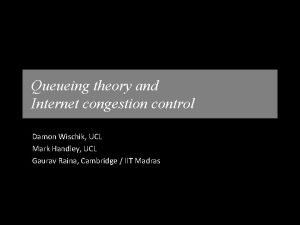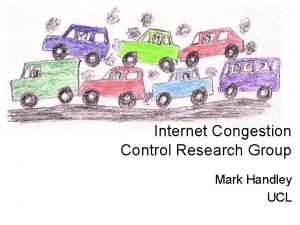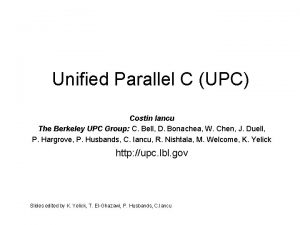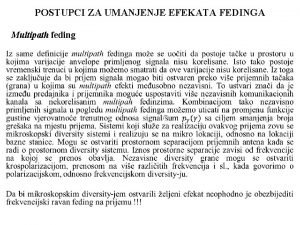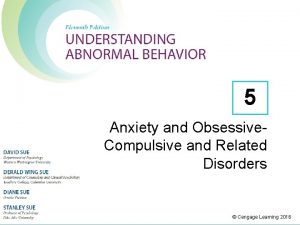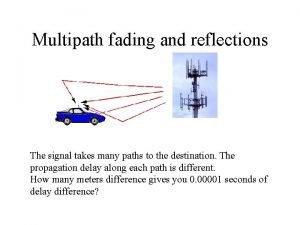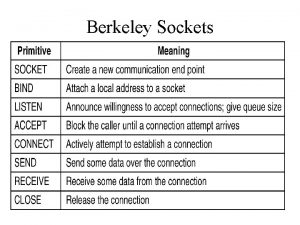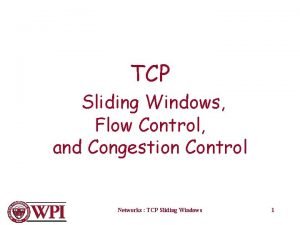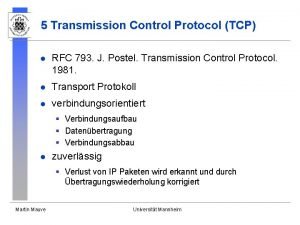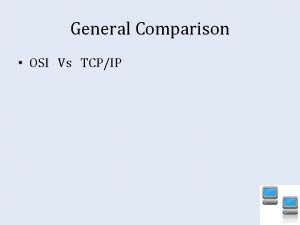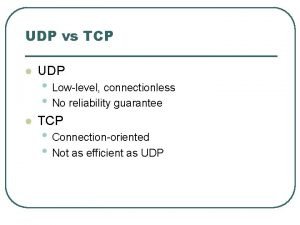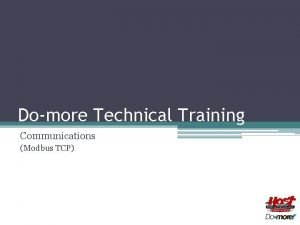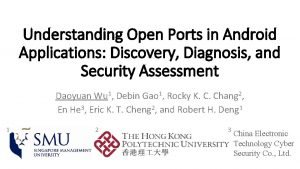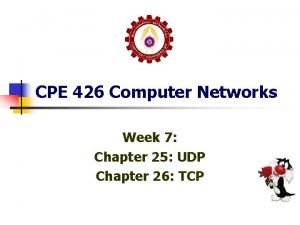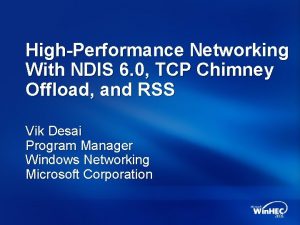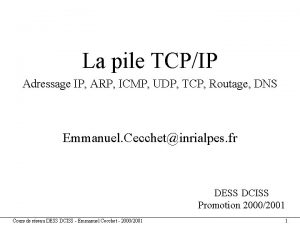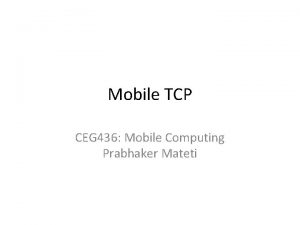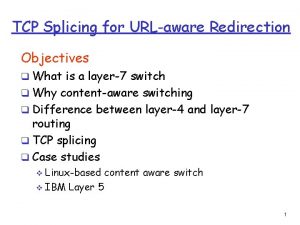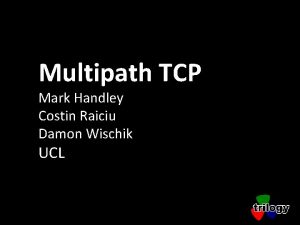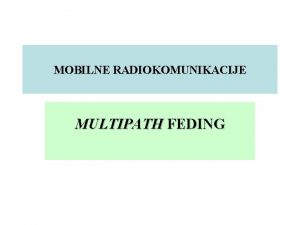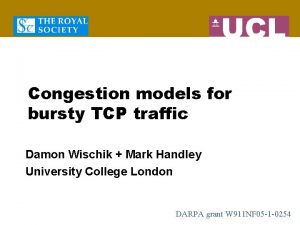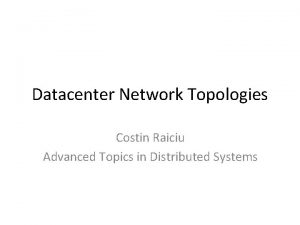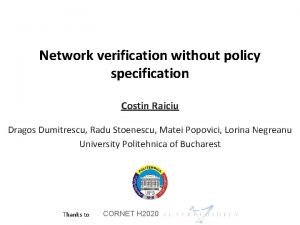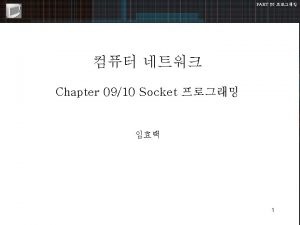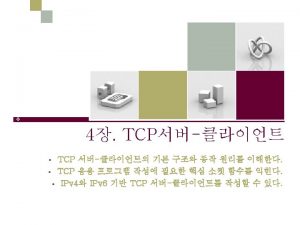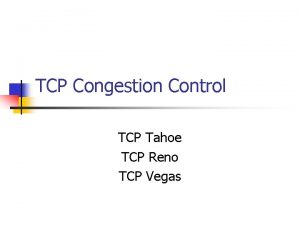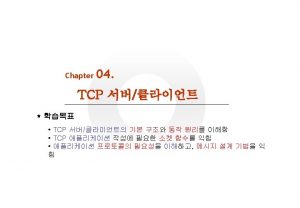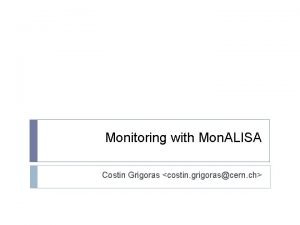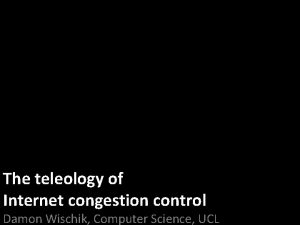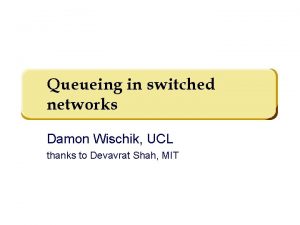Multipath TCP Mark Handley Costin Raiciu Damon Wischik














































![We devised a parameterized family of multipath congestion control algorithms, indexed by φϵ[0, 2], We devised a parameterized family of multipath congestion control algorithms, indexed by φϵ[0, 2],](https://slidetodoc.com/presentation_image_h/1adfb80f34f3cdd517d7ac6a1365f6ed/image-47.jpg)

















- Slides: 64

Multipath TCP Mark Handley Costin Raiciu Damon Wischik UCL

We have a working implementation of multipath transport wifi laptop with multipath TCP 3 G server with multipath TCP

We have a working implementation of multipath transport wifi laptop with multipath TCP 3 G server with multipath TCP wifi throughput [Mb/s] 3 G throughput [Mb/s] time [min]

This user clearly benefits from multipath. But is it safe for the network and other users? Or does it cause instability, route flap, unfairness, disaster?

This user clearly benefits from multipath. But is it safe for the network and other users? Or does it cause instability, route flap, unfairness, disaster? I. Resource pooling as a design principle The earliest design goal of the Internet aimed to achieve “resource pooling”, and multipath transport is a natural extension. II. How to measure the pooling potential of a multipath topology We have a metric for measuring how much resource pooling there can be, given the topology and traffic matrix. This will be useful for designing multipath routing algorithms. III. A coupled congestion control algorithm We have designed and implemented a multipath congestion control algorithm that balances load, and we can guarantee it’s safe to deploy (but it’s harder than you’d think to do it right)

I. Resource pooling as a design principle Resource pooling means “making a collection of resources behave like a single pooled resource”. It has been a design goal of the Internet from the beginning. A single link, split into two circuits Packet switching “pools” the two circuits Multipath “pools” the two links

Resource pooling means the network is better able to accommodate a surge in traffic or a loss of capacity by shifting traffic and thereby “diffusing” congestion across the network.

The Internet already has resource pooling, in the form of multi-homing, BGP, etc.

The Internet already has resource pooling, in the form of multi-homing, BGP, etc.

The Internet already has resource pooling, in the form of multi-homing, BGP, etc.

The Internet already has resource pooling, in the form of multi-homing, BGP, etc. We think resource pooling should be achieved by end-system multipath. This would harness the rapid responsiveness of end systems.






Resource pooling relies on there being enough path choices, and enough traffic that can make a choice. There is enough diversity of useful paths to achieve complete resource pooling. The network has split into two resource pools, because neither of the bottom two flows can access the top resource pool. Topic II. How much resource pooling can be achieved, given a set of multipath routes and a traffic matrix? Will there be one big pool, or many small pools?

Resource pooling relies on proper load-balancing by the end-systems. Using an idealized coupled congestion controller, there is resource pooling Using separate TCP controllers for each path, congestion is not equalized and capacity is not shared Topic III. Can we design a congestion controller such that users react in the right way to achieve resource pooling? If they don’t, there may be a single pool but it won’t be shared properly.

Topic II. How much resource pooling can be achieved, given a set of multipath routes and a traffic matrix? For the purposes of network-wide resource pooling, • Is it sufficient to use end-host addressing? • How much path diversity is enough, and what sort of diversity is useful? To answer this, we first need a metric for the amount of resource pooling that a network achieves.

How should we measure resource pooling? It means “making a collection of resources behave like a single pooled resource”. To measure resource pooling, we need to decide what we mean by “behave” and “like a single resource”.

How should we measure resource pooling? It means “making a collection of resources behave like a single pooled resource”. To measure resource pooling, we need to decide what we mean by “behave” and “like a single resource”. “Behave” Resource pooling has the consequence that congestion hotspots can be diffused across the network. So the behaviour I shall examine is “what is the change in congestion at a link, in response to a change in the capacity at that link? ”

How should we measure resource pooling? It means “making a collection of resources behave like a single pooled resource”. To measure resource pooling, we need to decide what we mean by “behave” and “like a single resource”. “Behave” Resource pooling has the consequence that congestion hotspots can be diffused across the network. So the behaviour I shall examine is “what is the change in congestion at a link, in response to a change in the capacity at that link? ” “Like a single resource” Suppose for example that • at an isolated link with capacity 100 Mb/s, the loss of 50 Mb/s increases packet loss by a factor of 20 • at an isolated link with capacity 1 Gb/s, the loss of 50 Mb/s increases packet loss by a factor of 1. 03 • at a resource-pooling link with capacity 100 Mb/s, the loss of 50 Mb/s increases packet loss by a factor of 1. 03 Then we’ll say that the “effective pooled capacity at that link” is 1 Gb/s.

A simple flow allocation problem

A simple flow allocation problem (matrix form)

A simple flow allocation problem (relaxed)

We want to know how the solution changes when capacities change. I shall take y to be fixed, and only look at how x changes.

We want to know how the solution changes when capacities change. I shall take y to be fixed, and only look at how x changes. Write out the complementary slackness conditions Take the total derivative with respect to Cj for some j Solve for dzi/d. Cj using linear algebra

Theorem At an isolated link, In a network with idealized multipath congestion control I call Ψjj the “poolability score”, and Cj/(1 -Ψjj) the “effective pooled capacity”.

If the poolability score is Ψjj ≈1 then the link sheds load easily. If the poolability score is Ψjj ≈0 then the link is “solitary”.

If the poolability score is Ψjj ≈1 then the link sheds load easily. If the poolability score is Ψjj ≈0 then the link is “solitary”.

There is a close link between the multi-commodity flow problem, and the multipath rate problem.

There is a close link between the workloads in heavy traffic, and poolability.

GEANT data provided by UCL Belgium multipath routes, link capacities, and traffic matrices

2005 -05 -04 16: 30: 00 Colours show utilization Grey shows effective pooled capacity

2005 -05 -04 17: 45: 00 Colours show utilization Grey shows effective pooled capacity

2005 -05 -04 19: 00 Colours show utilization Grey shows effective pooled capacity

2005 -05 -04 20: 15: 00 Colours show utilization Grey shows effective pooled capacity

Topic III. Can we design a congestion controller such that users react in the right way to achieve resource pooling? In the analysis of resource pooling, I assumed an idealized congestion controller: one which knows exactly the level of congestion on each path, and shifts its traffic onto the least congested. To achieve this, we thought it would be a simple matter of taking a published “fluid model” of a load-balancing congestion controller, and implementing it. [Kelly+Voice, 2005; Han, Shakkottai, Hollot, Srikant, Towsley (2006)]

Topic III. Can we design a congestion controller such that users react in the right way to achieve resource pooling? In the analysis of resource pooling, I assumed an idealized congestion controller: one which knows exactly the level of congestion on each path, and shifts its traffic onto the least congested. To achieve this, we thought it would be a simple matter of taking a published “fluid model” of a load-balancing congestion controller, and implementing it. [Kelly+Voice, 2005; Han, Shakkottai, Hollot, Srikant, Towsley (2006)] We were wrong.

The idealized congestion control algorithm puts all its traffic on the least congested path. This can a failure of load balancing, when congestion levels vary. Each flow should get 1/5 of the pool. The multipath flow should shift to using the top link. Then each flow gets 1/4 of the pool. The multipath flow is not using the lower link, so it never learns it should shift back.

The noisy nature of congestion feedback makes it difficult to estimate congestion levels. The top link is so congested! loss rate 1% random ▼ ▼ ▼ drops random ▲ drops ▼ ▲▲ ▲ ▼ ▼▼ ▲ ▼▼ ▼ ▼ ▲ ▲ I better switch to the bottom link. ▼▼ ▼▼ ▲ ▲▲ ▲ ▲ Now the bottom link is more congested! ▼ ▲

There is a large body of work on fluid models of congestion control: • write down a network utility maximization problem, • write down a system of differential equations, • show that the (unique) fixed point solves the utility maximization, • and interpret it as a discrete congestion control algorithm. Multipath congestion control theory has been developed by Kelly and Voice (2005), and by Han, Shakkottai, Hollot, Srikant, Towsley (2006). Interpretation • Increase xr by a constant, every time you get an acknowledgement on path r • Decrease xr by an amount proportional to ys(r) if you detect a drop on path r

How we expect the fluid model to behave:

How they behave in simulation: When there are many flows, then each flow will flip independently, and the aggregate will behave how the fluid models predict.

The information feedback stream (packet drops, delays) is noisy. To get a good measure of the true state of the link, we have to average the signal. But congestion is not static. To react promptly to changes in congestion, we have to look only at recent data about congestion, and we should constantly probe all paths.

The information feedback stream (packet drops, delays) is noisy. To get a good measure of the true state of the link, we have to average the signal. But congestion is not static. To react promptly to changes in congestion, we have to look only at recent data about congestion, and we should constantly probe all paths. The Zen of resource pooling To pool resources effectively, the end-system should not try too hard to pool resources. Instead, it should maintain equipoise, i. e. balance its traffic rate across its paths, to the extent necessary to achieve resource pooling.
![We devised a parameterized family of multipath congestion control algorithms indexed by φϵ0 2 We devised a parameterized family of multipath congestion control algorithms, indexed by φϵ[0, 2],](https://slidetodoc.com/presentation_image_h/1adfb80f34f3cdd517d7ac6a1365f6ed/image-47.jpg)
We devised a parameterized family of multipath congestion control algorithms, indexed by φϵ[0, 2], to investigate the tradeoff between load balancing and equipoise. φ=0 the idealized congestion controller, inspired by Kelly+Voice φ=2 run independent TCP control on each path

How good is this congestion controller at achieving resource pooling, in a static network? φ=0 good at resource pooling: even though the links have unequal capacities, congestion is balanced perfectly φ=2 bad at resource pooling: the low-capacity link is highly congested

How good is this congestion controller at achieving resource pooling, in a dynamic network? φ=0 bad at resource pooling: shifts too enthusiastically to the less loaded link, and is slow to learn when the other link improves φ=2 good at resource pooling: constantly probes both links, so learns quickly when congestion levels change

the naïve coupled congestion controller, inspired by Kelly+Voice φ=0 static network dynamic network run independent TCP control on each path φ=2 good at resource pooling: even though the links have unequal capacities, congestion is balanced perfectly bad at resource pooling: the low-capacity link is highly congested bad at resource pooling: shifts too enthusiastically to the less loaded link, and is slow to learn when the other link improves good at resource pooling: constantly probes both links, so learns quickly when congestion levels change

the naïve coupled congestion controller, inspired by Kelly+Voice φ=0 static network dynamic network run independent TCP control on each path φ=2 good at resource pooling: even though the links have unequal capacities, congestion is balanced perfectly bad at resource pooling: the low-capacity link is highly congested bad at resource pooling: shifts too enthusiastically to the less loaded link, and is slow to learn when the other link improves good at resource pooling: constantly probes both links, so learns quickly when congestion levels change

We tweaked the φ algorithm, to ensure fairness with TCP. We assign a weight to each link, and run a weighted version of the φ-algorithm. We have an adaptive algorithm for choosing the weights, to guarantee that • the multipath user gets as least as much throughput as if he/she used the best single path • the multipath user takes no more bandwidth on any link than a single-path TCP would. more congested short RTT less congested long RTT

The 3 G link has lower drop probability. We’d prefer to use the 3 G link, to get resource pooling. But the 3 G link has a long RTT, so single-path TCP gets low throughput. We shouldn’t take any more than single-path TCP would. Therefore we need to keep some traffic on the wifi link, so that the multipath user gets as good throughput as if he used singlepath TCP. what a singlepath TCP flow gets what a multipath flow gets wifi throughput [Mb/s] Congested, short RTT 3 G throughput [Mb/s] Uncongested, long RTT time [0 — 12 min]

Theorem Let xr be the fixed-point throughput on path r of our multipath algorithm, and let xr. TCP be throughput that a single-path TCP flow on that path. Assume that packet drop probabilities are given. Then

But is there a principled way to think about the congestion control problem?

But is there a principled way to think about the congestion control problem? * * “Resource pricing and the evolution of congestion control”, Gibbens and Kelly, 1999. *

But is there a principled way to think about the congestion control problem?

Control: at what rate the user should send packets This is the Bellman equation for a long-term average-cost dynamic programming problem. ! State: the user’s current belief about the network Plant: Bayesian update of user’s beliefs, based on acknowledgements and drops, and incorporating a preconceived notion of how quickly congestion levels might fluctuate Note: this equation is a toy model for single-path congestion control, not multipath.

We consider a model in which, each round trip time (RTT), the user chooses how many packets to send in that RTT. We assume u ϵ {0, 1, …, umax}. D is the number of dropped packets. The reward is u-D, the number of delivered packets. The cost is γD, for some constant γ>0.

The distribution of D depends on the packet drop probability, Q. The user’s current Bayesian belief about Q is specified by a Beta distribution, parameterized by n and p. (Here, p is the expected drop probability and n is the “amount of evidence” for p. ) The user’s belief about q is updated every RTT, in two ways: the user gains information about the distribution of Q, from observing D congestion levels may change over an RTT, which adds uncertainty to the distribution of Q. That is, the network is a restless bandit.


I solved the Bellman equation numerically, and derived an optimal congestion control algorithm. I then ran this algorithm on a link with packet drop probability 0. 02.

SUMMARY. We have a working implementation of multipath transport. It achieves a reasonable degree of load balancing. This means that the network achieves some degree of resource pooling (subject to having good enough routes). It maintains a reasonable degree of equipoise. This means it adapts sensibly to fluctuating congestion. It is guaranteed to be fair compared to TCP. The algorithm is ready for deployment. It is an experimental RFC in the mptcp working group at the IETF.

Ongoing research topics How can we use poolability scores to help design a multipath routing algorithm? Is it sufficient to rely on end-host addressing? Can multipath TCP help achieve resource pooling in data centres? Can multipath TCP make good routing choices in ad-hoc wireless networks? Does the dynamic programming approach shed light on CUBIC, Compound TCP etc. ? Why has classic TCP worked so well? What is the impact of resource pooling on competition and pricing? Will it drive network operators to switch to congestion volume pricing?
 Costin raiciu
Costin raiciu Damon wischik
Damon wischik Damon wischik
Damon wischik Damon wischik
Damon wischik Demon a 6 queus
Demon a 6 queus Mark handley ucl
Mark handley ucl Zoe handley
Zoe handley Costin iancu
Costin iancu Costin damasaru cv
Costin damasaru cv Scoala miron costin suceava
Scoala miron costin suceava Miron costin suceava
Miron costin suceava Multipath
Multipath Multipath
Multipath Multipath model of anxiety disorders
Multipath model of anxiety disorders Multipath reflection
Multipath reflection One dimensional model psychology
One dimensional model psychology Lucian wischik
Lucian wischik Damon devitt
Damon devitt Zu dionys dem tyrannen schlich damon dolch gewande
Zu dionys dem tyrannen schlich damon dolch gewande Al pacino conjoint
Al pacino conjoint Damon burton
Damon burton Neural tensor network
Neural tensor network Damon cottrell
Damon cottrell Damon burton
Damon burton Fortran c interoperability
Fortran c interoperability Dr frost interior and exterior angles
Dr frost interior and exterior angles Accu poole sept
Accu poole sept Damon and pythias story
Damon and pythias story Skipton girls' high school
Skipton girls' high school Moloch aol
Moloch aol Talented mr ripley chapter summary
Talented mr ripley chapter summary Den dolch im gewande
Den dolch im gewande Damon's stages of friendship
Damon's stages of friendship Shayok chakraborty
Shayok chakraborty Damon burton
Damon burton Damon zucca
Damon zucca Mst damon
Mst damon Quadratics dr frost
Quadratics dr frost Damon zucca
Damon zucca Damon's stages of friendship
Damon's stages of friendship Damon poole
Damon poole Damon burton
Damon burton Berkeley socket primitives
Berkeley socket primitives Encapsulation and decapsulation in osi model
Encapsulation and decapsulation in osi model Tcp sliding window mechanism
Tcp sliding window mechanism L
L Tcp fao
Tcp fao Osi vs tcp ip
Osi vs tcp ip Tcp selective ack
Tcp selective ack Tcp vs udp
Tcp vs udp Tcp connection management finite state machine
Tcp connection management finite state machine Tcp reliable data transfer
Tcp reliable data transfer Desventajas del modelo tcp/ip
Desventajas del modelo tcp/ip Sliding window flow control
Sliding window flow control Modbus training
Modbus training Open ports android
Open ports android Tcp flow control
Tcp flow control Tcp chimney offload windows 10
Tcp chimney offload windows 10 台大tcp
台大tcp Arp icmp
Arp icmp Model tcp/ip
Model tcp/ip Java raw socket
Java raw socket Transmission timeout freezing in mobile computing
Transmission timeout freezing in mobile computing Similitudes del modelo osi y tcp/ip
Similitudes del modelo osi y tcp/ip Tcp splicing
Tcp splicing

